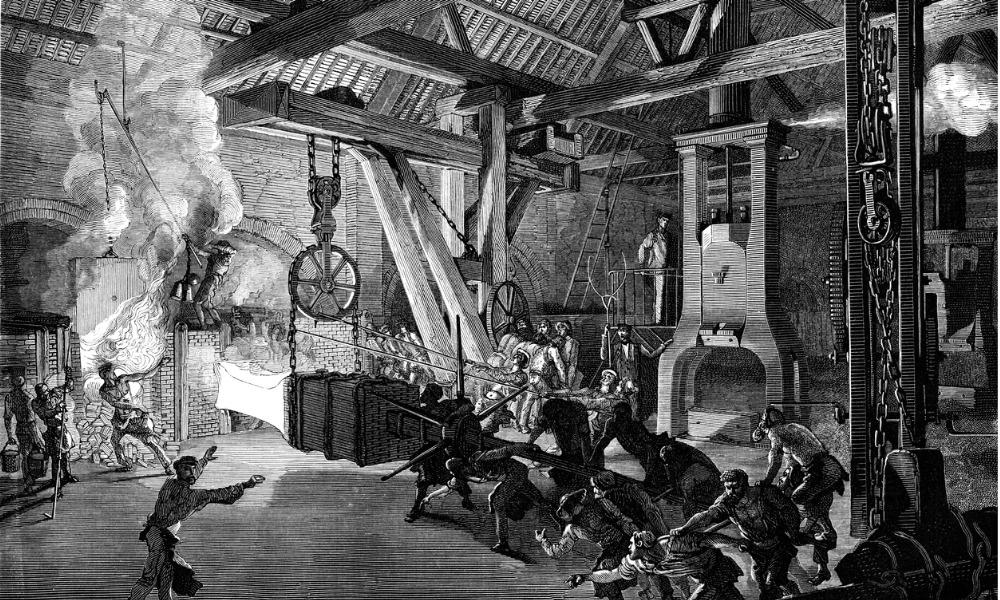Workplace health and safety in Canada can be traced all the way back to the 1880s…

This article is the first in a series covering the history of occupational health and safety. Over the next few weeks we shall be taking a look at how OHS developed in Canada on a provincial and federal level between the 1880s and the 1980s, and how key events have shaped our understanding of workplace safety today.
Workplace health and safety in Canada really all begins in 1884, with the Factory Act.
This was inspired by the British Factory Acts, a series of Acts passed from 1833, which were to improve the working conditions of those in industrial employment – with early efforts notably focusing on the working conditions of children.
The Act was passed in 1884, but not declared in force until 1886 – and it was, as its name may suggest, only applicable to those working in factories. This means that people working in mines or in agricultural settings were not covered by the Act.
The Industrial Revolution and new workplace hazards
By the 1880s, Canada was an autonomous dominion within the British Empire, and in the midst of its Second Industrial Revolution.
Provinces in Canada were affected differently by these changes. In B.C., the economy was primarily extractions-based (e.g. coal), where workers faced incredibly harsh conditions: “Government statistics showed Vancouver Island coal mines to be by far the most dangerous in the world” according to the Anjan Chaklader’s report on the history of Workers’ Compensation in B.C. (May 1998).
Coal, steel and shipbuilding industries also developed in Nova Scotia.
But it was really in Ontario and Quebec where industrialisation boomed and gave way to factory life, which also led to the creation of new workplace hazards for workers.
“The introduction of steam powered machinery, new technologies, and large crowded workplaces combined with the intensification of the labour process through speed-ups, higher levels of supervision and discipline, piece work wages, and sweating produced serious occupational health and safety hazards for workers,” says Eric Tucker (Making the Workplace 'Safe' in Capitalism: The Enforcement of Factory Legislation in Nineteenth Century Ontario, 1988, Osgoode Hall Law School of York University).
Tucker says that initially, the state did not regulate workplace safety, with there being a legal presumption that essentially, workers took on the work with the knowledge that risks were present in the workplace.
“In the 19th century there were all kinds of horrors stories, very young women – we might even call them kids – in the needle trades industry who would get injured being around sewing machines,” says Laurel MacDowell, a professor of history at the University of Toronto.
If there were some serious accidents they would be looked into, but there was no continuous infrastructure to deal with health and safety issues, she says.
Attention just wasn’t really paid to them, says MacDowell. “You would go to work for long hours and be paid relatively little. And you put up with the conditions as they were…They needed money and it was just accepted that this was what was done.”
Labour movements and the impetus behind change
The Trade Union Act of 1872 legalized and protected unions.
This Act was the result of a strike led by the Toronto Typographical Union demanding a nine-hour workday. Before the Trade Union Act, union activity was criminal. These events eventually lead to the establishment and celebration of Labour Day in Canada. The Canadian Labor Union was founded in 1873, and was succeeded by the Trades and Labor Congress of Canada in 1883.
All this to say that unions and the labour movement were gaining traction in Canada, especially in heavily industrialised provinces like Quebec and Ontario.
It is highly likely that the increasing social and political power of unions and the labour movement created the strong push towards improving the health and safety of factory workers.
MacDowell says that the labour movement and unions played a crucial role: “As the country became more industrialized and as the labour movement grew to put pressure on [working conditions], you begin to get a more sophisticated discussion of it and of the problems and then eventually you get some infrastructure.”
“As time went on, people began to realize that you shouldn’t risk your health or your life because you’re at a job.” Says MacDowell.
Improving working conditions for women and children
The Factory Act regulated a number of things, including child and female labour. For example, a 10 hour workday (and 60 hour work week) was established as the maximum hours of work for children.
Tucker says that other provisions included “minimum standards regarding cleanliness, overcrowding, ventilation and closet accommodation, including a requirement for separate closet facilities for men and women.”
Another interesting new provision brought about by the Act was that the appropriate authorities could now designate an inspector, who “was empowered to enter and inspect factories at all reasonable times without a warrant, unless the premises were also used as a dwelling,” says Tucker.
A flawed but promising start
According to the Windsor Occupational Health Information Service (WOHIS), this Act “was important in that it suggested prohibitions on the work activities of children and women and suggested work hour restrictions for all employees.”
However WOHIS says that the Act was in fact relatively vague and unenforceable.
“There were some conditions, and occasionally there were inspectors, but enforcement was the problem,” says MacDowell.
Nevertheless it did remain one of the main pieces of workplace legislation in Canada for a very long time and was only really updated 80 years later in 1964 with the Industry Safety Act (which we shall take a look at later on in our series).
And though not perfect, the Act is nevertheless an essential part of Canada’s OHS history and the first brick in the long path towards a safe and healthy workplace.
Sources:





